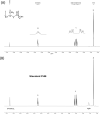Characterization of newly isolated thermotolerant bacterium Cupriavidus sp. CB15 from composting and its ability to produce polyhydroxyalkanoate from glycerol
- PMID: 37046250
- PMCID: PMC10091600
- DOI: 10.1186/s12934-023-02059-5
Characterization of newly isolated thermotolerant bacterium Cupriavidus sp. CB15 from composting and its ability to produce polyhydroxyalkanoate from glycerol
Abstract
Background: This study aimed to isolate a novel thermotolerant bacterium that is capable of synthesizing polyhydroxyalkanoate from glycerol under high temperature conditions.
Results: A newly thermotolerant polyhydroxyalkanoate (PHA) producing bacterium, Cupriavidus sp. strain CB15, was isolated from corncob compost. The potential ability to synthesize PHA was confirmed by detection of PHA synthase (phaC) gene in the genome. This strain could produce poly(3-hydroxybutyrate) [P(3HB)] with 0.95 g/L (PHA content 75.3 wt% of dry cell weight 1.24 g/L) using glycerol as a carbon source. The concentration of PHA was enhanced and optimized based on one-factor-at-a-time (OFAT) experiments and response surface methodology (RSM). The optimum conditions for growth and PHA biosynthesis were 10 g/L glycerol, 0.78 g/L NH4Cl, shaking speed at 175 rpm, temperature at 45 °C, and cultivation time at 72 h. Under the optimized conditions, PHA production was enhanced to 2.09 g/L (PHA content of 74.4 wt% and dry cell weight of 2.81 g/L), which is 2.12-fold compared with non-optimized conditions. Nuclear magnetic resonance (NMR) analysis confirmed that the extracted PHA was a homopolyester of 3-hydyoxybutyrate.
Conclusion: Cupriavidus sp. strain CB15 exhibited potential for cost-effective production of PHA from glycerol.
Keywords: Cupriavidus sp.; Glycerol; Polyhydroxyalkanoate; Thermotolerant bacterium.
© 2023. The Author(s).
Conflict of interest statement
The authors declare that they have no competing interests.
Figures








References
MeSH terms
Substances
LinkOut - more resources
Full Text Sources
Molecular Biology Databases

